19 Fun Pieces of Computer History From the Museum of Interesting Things
The Original DIY Robot
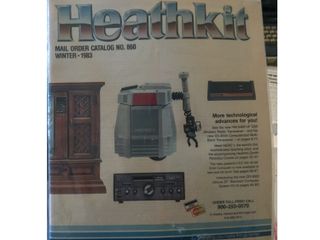
Bonus: Check out one of the catalogues where tech enthusiasts would browse for their next Heathkit.
Apple Lisa
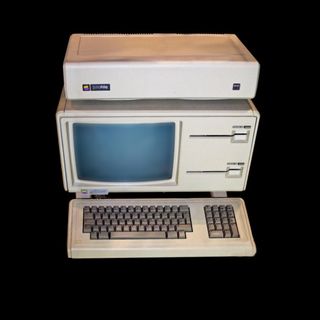
The Apple Lisa debuted in 1983, making a name for itself as one of the first PCs with a graphical user interface (GUI).
Speaking of names, what’s with the name? While a seemingly clever take on the Mona Lisa painting and said to stand for Local Integrated Software Architecture, it was also long debated whether or not the machine was also named after Steve Jobs’ daughter, Lisa Brennan-Jobs. That debate can now be laid to rest, thanks to Brennan-Jobs’ tell-all book Small Fry, which came out earlier this month. In the book, the author says Jobs admitted to naming the PC after her.
Beyond some controversy, the Apple Lisa is a part of PC history. It represents one of Apple’s least successful pieces of hardware, partially due to its astronomical price. After selling just 100,000 units in its first two years (not a great figure, considering the first Macintosh sold 70,000 units in its first three months), the PC was taken off market. But it remains infamous as helping to almost put Apple out of business.
Apple Lisa Specs
- CPU: Motorola 68000, 5MHz
- Memory: 1MB, expandable up to 2MB
- Display: 12 inches, 720 x 365 resolution
- Operating System: Apple Lisa GUI
- Ports: 1x parallel, 1x mouse, 2x serial
- Storage: 2x 5.25-inch floppy drives, 1x external hard drive, 5MB (optional)
- Price: $9,995 (about $25,000 today)
Credit: Wikimedia Commons
The iPad’s Great-Great-Great-Grandfather
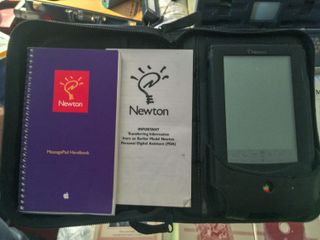
Apple has carved a seemingly permanent spot in the portable computer category with its iPads. But the company has been working on this idea since way before the first iPad launched in 2010.
Stay On the Cutting Edge: Get the Tom's Hardware Newsletter
Join the experts who read Tom's Hardware for the inside track on enthusiast PC tech news — and have for over 25 years. We'll send breaking news and in-depth reviews of CPUs, GPUs, AI, maker hardware and more straight to your inbox.
The company’s original foray into this space was actually the Apple Newton PDA, which first appeared in 1993 and was killed off (by Jobs) in 1998. Apple launched four Newton MessagePads in this time period. Pictured here is the first, the MP100.
QWERTY’s Biggest Threat
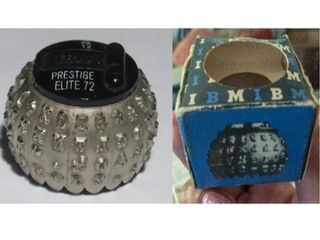
IBM’s Selectric typewriter click-clacked onto the scene in 1961. What made the machine so successful (selling 13 million units by 1986) was its efficient typing response, made possible after IBM brought a special ball, which had already existed for decades, to the U.S. The ball replaced traditional typewriter bars that would often clump up and stick together if you typed too fast.
However, Daniels tells us that today’s QWERTY keyboard layout, which became common in 1878, was actually designed to slow down typists and prevent that issue. But by the time IBM’s technology came around, people were too used to the QWERTY standard to allow change.
Some, however, remain hopeful.
“Typewriter societies are trying to bring [other keyboard layouts] back, but no one wants to change the keyboard. ... But had we had the ball, we would’ve been using better systems for 100 years, and you never would've known QWERTY existed,” Daniels says.
Need proof? Germany actually had this technology before IBM, making for more efficient keyboard layouts like that seen on 1893’s Blickensderfer #5 (pictured on next page).
Credit: Scs/Wikimedia Commons and Scharon Harding/Tom's Hardware
QWERTY’s Biggest Threat

See? The Blickensderfer #5 is proof that QWERTY isn't the only way.
IBM Punch Cards

Putting these on the list (or in a museum) was a no-brainer. IBM punch cards were a major update to the bigger, bulkier cards used in jacquard looms throughout the 1800s.
IBM’s first punch cards “had 22 columns and eight punch positions; then 24 columns and 10 positions (1900); and until the late 1920s, it had 45 columns of round holes and 12 punch positions. But it was not enough, as customers needed to put more data on each card," according to IBM.
So, there was eventually an internal competition, which researcher Clair D. Lake's team won. The winning formula? A 7.375 x 3.25-inch rectangle with smaller holes that were easier for metal tabulators to read, but called for new machines. IBM chose it because “it could be implemented quickly and required the least adjustment in how tabulating machines worked.” And IBM “wanted to move away from round-holed machines, which were more common. Nobody had rectangular holes.”
These cards are also a big part of IBM’s success. The company says the cards helped it make a name in data processing. And as recently as the mid-1950s the cards accounted for up to 20 percent of IBM' revenue.
The First Floppy Disks
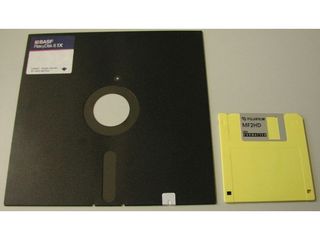
Now that’s a lot of floppy! Just look at it overshadowing its 3.5-inch baby brother. The first floppy disks were 8-inchers that came to market in 1971. They first debuted as part of IBM products before companies like Memorex started selling them individually in 1972.
Credit: Thomas Bohl/Wikimedia Commons
PC Gaming Geekdom
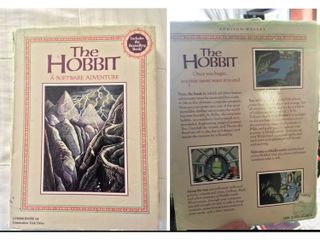
Nothing quite beats gaming, huh? What else allows you to be as athletic, musical, violent, boring or non-human as you want?
While there were other PC games before The Hobbit software game (see 1950’s Bertie the Brain, 1952’s OXO, or even IBM’s 1981 Microsoft Adventure), this 1982 Hobbit PC game makes the list, not just because we saw it at the Museum of Interesting Things, but because of the sheer geekiness (The Hobbit, hello) it brought to the PC world.
The Hobbit was originally made for ZX Spectrum PCs before being made available on other platforms, including the Commodore 64 (pictured), BBC Micro and Oric. And if that’s not enough geekdom for you, note the game came with a copy of J.R.R. Tolkien’s book. Score!
And Again....
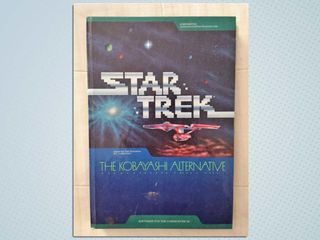
Similarly, it’s safe to bet this PC game, Star Trek: The Kobayashi Alternative, had an impact on the lives of many an early PC gaming geeks. This game came out in 1985 and was available on Apple II, Macintosh, Commodore 64 and IBM PC.
Scharon Harding has a special affinity for gaming peripherals (especially monitors), laptops and virtual reality. Previously, she covered business technology, including hardware, software, cyber security, cloud and other IT happenings, at Channelnomics, with bylines at CRN UK.
-
dennphill Thanks for a trip down memory lane! Last time Tom’s went through a history of computers…I enjoyed that as well. NOT in the IT business, though I have been assembling my own PCs for many years now…AMDs through 2015 and Intel since. Just a simple occasional user. (I went from MS-DOS to Win95 (in the mid 95s) to WinXP to Win7, and am now still plugging along with Win8.1. A total Luddite when it comes to Win10, though I may have to cave with my next build!)Reply
- First computer exposure in the early 1960s was studying engineering at VPI and lugging around punch cards for the school’s IBM 360! I suspect my current Haswell–based i5-4440 with a 512GB SSD and a 2GB HDD sitting on my desk is probably at least as powerful!
- I had a good friend, when we were pilots flying for the Pentagon at Ft. Belvoir back in the early 1980s, who came home one day and showed me an Osborne he had just bought. I remember playing with it and seeing what we could get it to do.
Again, thanks Scharon! Good article. ? -
bit_user Reply
I came for "19 Fun Pieces of PC History". Hardly any of these had to do with PCs.21322445 said:From Victorian-era self-playing instruments to early IBM and Apple systems, we found several tech artifacts that contributed to the PC market in their own way.
Please fix the title. After the work you put into this, you don't want to setup your readers for disappointment. Also, some of these items might interest those wishing to remain blissfully ignorant of PC history. -
rogue17.mm yes it was a trip down memory lane but some of the objects or gadgets are not the first of its kind, i mean like it said that in 1993 the apple newton pda was the first portable computer but before that there was a palmtop that was first launched in 1989 or 1990 i thinkReply -
mortemas As I await the availability of nNidia's new gpus I have been thinking about how far we've come since my childhood when my first video game console was the Atari 2600 and a game like Pong was literally 2 lines (the paddles) and a dot (the ball). I remember using PovRay to make single ray traced images that took hours to complete on a home PC. Quite a few things on that list take me back to my younger years, as well as other items not mentioned. I remember our first modular handheld gaming system, Microvision, which flopped after 2 years on the market. Of course there were other electronic games before that, like football with the bubble display. I remember Epoch's portable space invaders clone with a vacuum display and loud, obnoxious sound effects that would tick off my family when I played it. My friend had a Vectrex, which was super cool at the time. Our family had an IBM Selectric. My first PC was a 10MHz 80286 (the IBM PS/2 50z), which had a 13" crt screen. My first modem was a Samsung running at 1200 baud, I think. That's 150 *bytes* of data per second! I grew up assembling Heathkit projects and I remember wanting the Hero bot so much! I still have a catalog like the one in this article, as well as the IM-2320 digital multimeter I assembled decades ago which I still use today. My PDA 18 years ago was a Handspring Visor Prizm. So, as I wait for the RTX 2080 ti I'm replaying an old game from 1981 on classicreload.com:Reply
https://classicreload.com/ultima.html
Now pardon me...I have to go slay a Balron -
mischon123 The IBM punch cards and the Holleriths were sold by IBM and made the Holocaust possible. Little known but important fact.Reply -
WyomingKnott How depressing. I just had to throw out a bunch of stuff that would have qualified, and I'm still in mourning.Reply -
Olle P The QWERTY-system wasn't so much to slow typists down as to put a physical distance between the bars for letters that are often written next to each other.Reply
Most Popular






